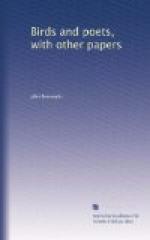Other northern visitors that tarried with me the same winter were the tree or Canada sparrow and the redpoll, the former a bird larger than the social sparrow or hair-bird, but otherwise much resembling it, and distinguishable by a dark spot in the middle of its breast; the latter a bird the size and shape of the common goldfinch, with the same manner of flight and nearly the same note or cry, but darker than the winter plumage of the goldfinch, and with a red crown and a tinge of red on the breast. Little bands of these two species lurked about the barnyard all winter, picking up the hayseed, the sparrow sometimes venturing in on the haymow when the supply outside was short. I felt grateful to them for their company. They gave a sort of ornithological air to every errand I had to the barn.
Though a number of birds face our winters, and by various shifts worry through till spring, some of them permanent residents, and some of them visitors from the far north, yet there is but one genuine snow bird, nursling of the snow, and that is the snow bunting, a bird that seems proper to this season, heralding the coming storm, sweeping by on bold and rapid wing, and calling and chirping as cheerily as the songsters of May. In its plumage it reflects the winter landscape,—an expanse of white surmounted or streaked with gray and brown; a field of snow with a line of woods or a tinge of stubble. It fits into the scene, and does not appear to lead a beggarly and disconsolate life, like most of our winter residents. During the ice-harvesting on the river, I see them flitting about among the gangs of men, or floating on the cakes of ice, picking and scratching amid the droppings of the horses. They love the stack and hay-barn in the distant field, where the farmer fodders his cattle upon the snow, and every red-root, ragweed, or pigweed left standing in the fall adds to their winter stores.
Though this bird, and one or two others, like the chickadee and nuthatch, are more or less complacent and cheerful during the winter, yet no bird can look our winters in the face and sing, as do so many of the English birds. Several species in Great Britain, their biographers tell us, sing the winter through, except during the severest frosts; but with us, as far south as Virginia, and, for aught I know, much farther, the birds are tuneless at this season. The owls, even, do not hoot, nor the hawks scream.




